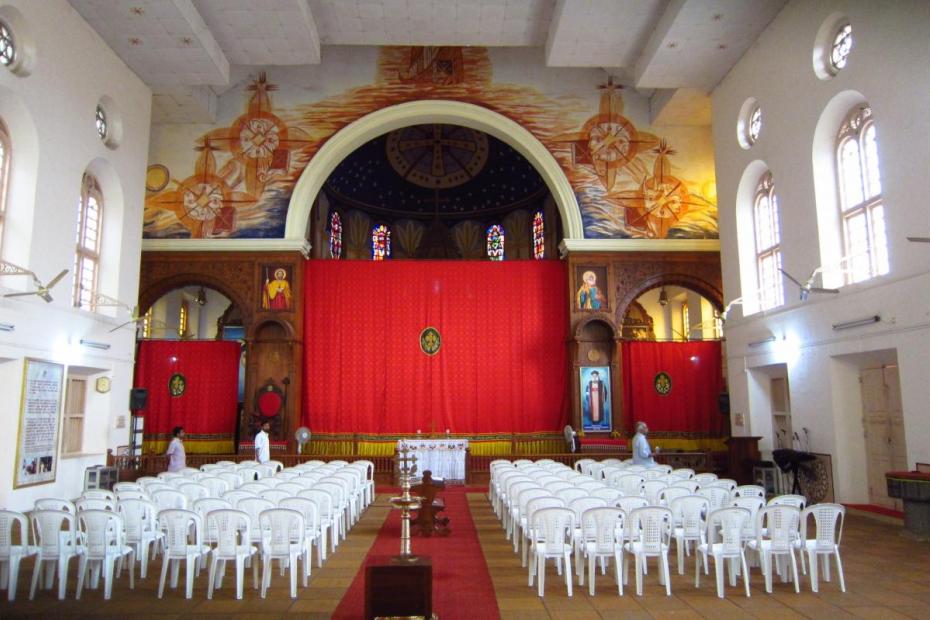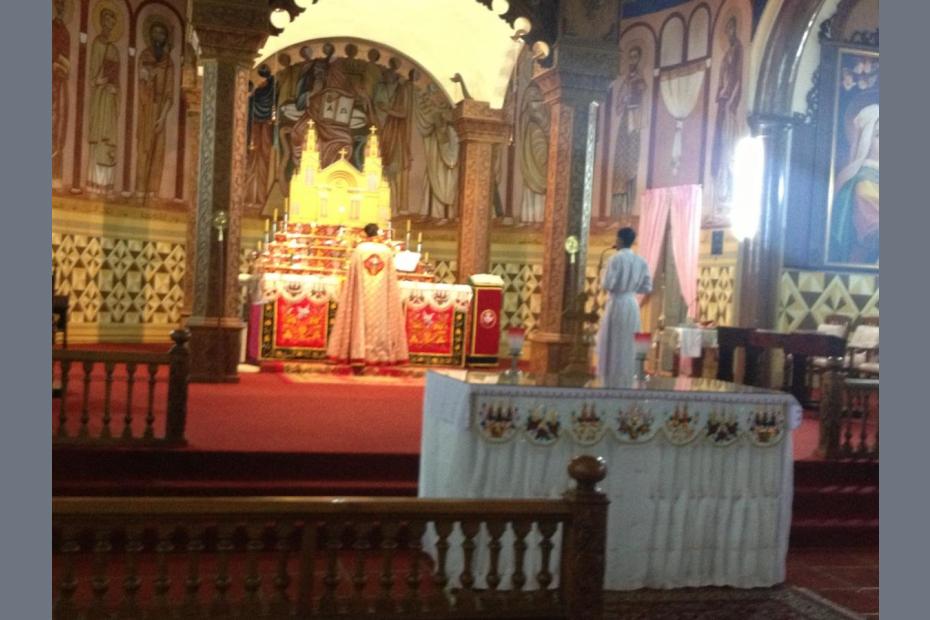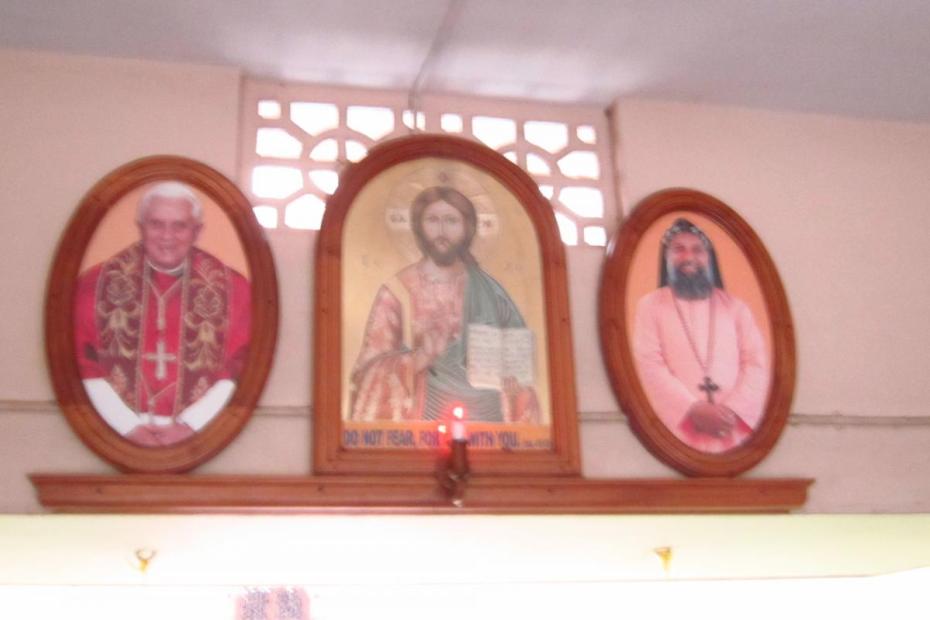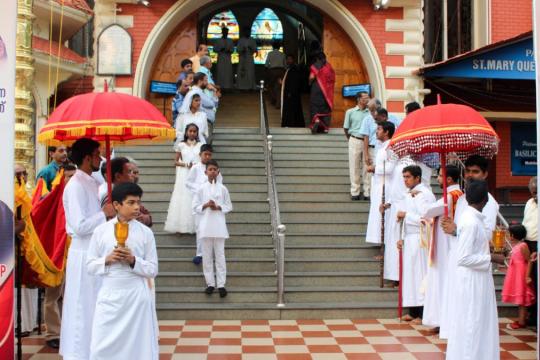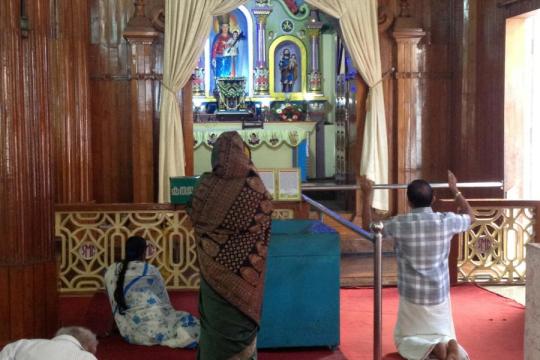While the Latin, Syro-Malabar and Syro-Malankara churches have their own hierarchy, histories and cultural practices, the particular forms of liturgy in each of the Syrian churches is what especially distinguishes the churches in the minds of clergy and laity. Preservation of that form is extremely important to Syro-Malankara Catholics.
The Syro-Malankara rite is drawn from the same West Syrian tradition as the Maronite Church and the Syriac Catholic church, whereas the Syro-Malabar liturgy is drawn from East Syrian liturgical traditions.
The Holy Qurbono, as the liturgy of the Syro-Malankara church is called, focuses a great deal on ritual, gesture and symbols. Chant is an important part of the liturgy, deeply integral to the liturgy, not simply an optional frame for it. "Malankara liturgy is soaked in music. What takes the worshipper to the zenith of a mystical experience in the Malankara liturgy is its musicality. In other words, one can say that musicality makes the Malankara liturgy mystical."1 Incense, bells and rich vestments also convey a sense of mystery.
According to a leading scholar of the liturgy, "A Malankara Church in its original architecture is divided mainly into Madbaho (the most holy place where there is the altar), Quaestrumo (the place of the choir which symbolizes heaven where the angels sing the glory of God) and Hyklo (the worshipping community, the people of God). This structure indicates that the temple of God is the earthly heaven and it is a meeting point of heaven and earth. The veil separates the Madbaho (the Holy of Holies) from the Hyklo (the place of the holy gathering)… The veil itself is the symbol of mystery. It represents the unapproachable and the incomprehensible stature of God.”2
The liturgy is celebrated today in local languages of the believers, such as Malayalam or English. “The hymns that are used in the Malankara liturgy are either the original Syrian hymns or their translations and the tunes are ‘Syrian tunes.’”3
The Service Book of the Holy Qurbono states:
"For Malankara Syrian Catholics, as with all Eastern Catholics, Christian spirituality is ecclesial in nature and is deeply rooted in the liturgy.... In the course of her history, the Malankara Church inherited this beautiful and profound liturgy from the West Syrian bishops who arrived in India following the unfortunate separation of 1653, and brought this ancient, theologically-rich, and beautiful liturgical tradition into the Catholic communion in 1930 with the Reunion of Archbishop Mar Ivanios.
“Ours is a liturgy rich in symbols, symbolic gestures and symbolic language. It is an ancient and apostolic liturgy. It is also the liturgy unique to an ecclesia sui iuris (autonomous Church) in the Universal Church with a long history. The liturgical and spiritual patrimony of the Malankara Catholic Church is that of the Antiochene Rite, though its celebration is uniquely Indian." 4
At Syro-Malankara liturgies, men and women generally separate into different sides of the church, a practice in keeping with many other aspects of Indian life. Shoes are left outside of church during Mass.
The Qurbono consists of four parts:
- An introductory rite, the Thuyobo, during which the curtain to the sanctuary remains closed, and the priest enters to prepare himself and the altar with prayers;
- The Thulmodo, or Service of the Word, when the veil of the sanctuary is open;
- The Anaphora, of Service of the Sacrifice, when the sanctuary veil is also open;
- The concluding prayers, during which the sanctuary veil is closed.
Texts with English translation of the the preparatory rites, Service of the Word, one of the Anaphora, and the concluding prayers of the Syro-Malankara Qurbono are below.
- 1 Philip Vysanethu, OIC, "Liturgy of the Hours in the Malankara Catholic Church" (lecture at the conference, "Catholic Cultures, Indian Cultures: A Workshop on Rites, Religiosity, and Cultural Diversity in Indian Catholicism," Bangalore, India, January 13, 2015).
- 2Philip Vyasanethu, Musicality Makes the Malankara Liturgy Mystical (Kottayam, India: St. Ephrem Ecumenical Research Institute, 2004), 88-89.
- 3Vyasanethu, Musicality Makes the Malankara Liturgy Mystical, 93.
- 4The Service Book of the Holy Qurbono, prepared by The Department of Sacred Liturgy of the Syro-Malankara Catholic Apostolic Exarchate in the United States (Trivandrum: The Major Archiepiscopal Curia of the Syro-Malankara Catholic Church, Catholicate Centre, 2012).
